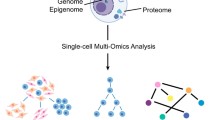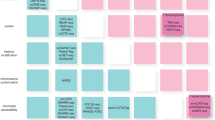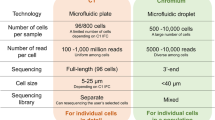Abstract
With the rapid advance of single-cell sequencing technology, cell heterogeneity in various biological processes was dissected at different omics levels. However, single-cell mono-omics results in fragmentation of information and could not provide complete cell states. In the past several years, a variety of single-cell multimodal omics technologies have been developed to jointly profile multiple molecular modalities, including genome, transcriptome, epigenome, and proteome, from the same single cell. With the availability of single-cell multimodal omics data, we can simultaneously investigate the effects of genomic mutation or epigenetic modification on transcription and translation, and reveal the potential mechanisms underlying disease pathogenesis. Driven by the massive single-cell omics data, the integration method of single-cell multi-omics data has rapidly developed. Integration of the massive multi-omics single-cell data in public databases in the future will make it possible to construct a cell atlas of multi-omics, enabling us to comprehensively understand cell state and gene regulation at single-cell resolution. In this review, we summarized the experimental methods for single-cell multimodal omics data and computational methods for multi-omics data integration. We also discussed the future development of this field.


Similar content being viewed by others
Data Availability
No data was generated for this manuscript.
References
Abugessaisa I, Noguchi S, Bottcher M et al (2018) SCPortalen: human and mouse single-cell centric database. Nucleic Acids Res 46(D1):D781–D787. https://doi.org/10.1093/nar/gkx949
Angermueller C, Clark SJ, Lee HJ et al (2016) Parallel single-cell sequencing links transcriptional and epigenetic heterogeneity. Nat Methods 13(3):229–232. https://doi.org/10.1038/nmeth.3728
Argelaguet R, Velten B, Arnol D et al (2018) Multi-omics factor analysis-a framework for unsupervised integration of multi-omics data sets. Mol Syst Biol 14(6):e8124. https://doi.org/10.15252/msb.20178124
Argelaguet R, Arnol D, Bredikhin D et al (2020) MOFA+: a statistical framework for comprehensive integration of multi-modal single-cell data. Genome Biology 21(1):111. https://doi.org/10.1186/s13059-020-02015-1
Ashuach T, Gabitto MI, Jordan MI et al (2021) MultiVI: deep generative model for the integration of multi-modal data. bioRxiv. https://doi.org/10.1101/2021.08.20.457057
Bakken TE, Jorstad NL, Hu Q et al (2021) Comparative cellular analysis of motor cortex in human, marmoset and mouse. Nature 598(7879):111–119. https://doi.org/10.1038/s41586-021-03465-8
Battich N, Stoeger T, Pelkmans L (2013) Image-based transcriptomics in thousands of single human cells at single-molecule resolution. Nat Methods 10(11):1127–1133. https://doi.org/10.1038/nmeth.2657
Biancalani T, Scalia G, Buffoni L et al (2021) Deep learning and alignment of spatially resolved single-cell transcriptomes with Tangram. Nat Methods 18(11):1352–1362. https://doi.org/10.1038/s41592-021-01264-7
Buenostro JD, Wu BJ, Litzenburger UM et al (2015) Single-cell chromatin accessibility reveals principles of regulatory variation. Nature 523(7561):486–U264. https://doi.org/10.1038/nature14590
Butler A, Hoffman P, Smibert P et al (2018) Integrating single-cell transcriptomic data across different conditions, technologies, and species. Nat Biotechnol 36(5):411–420. https://doi.org/10.1038/nbt.4096
Cao ZJ, Gao G (2022) Multi-omics single-cell data integration and regulatory inference with graph-linked embedding. Nat Biotechnol 40(10):1458–1466. https://doi.org/10.1038/s41587-022-01284-4
Cao Y, Zhu J, Jia P et al (2017) scRNASeqDB: a database for RNA-Seq based gene expression profiles in human single cells. Genes (Basel) 8(12):368. https://doi.org/10.3390/genes8120368
Cao JY, Cusanovich DA, Ramani V et al (2018) Joint profiling of chromatin accessibility and gene expression in thousands of single cells. Science 361(6409):1380–1385. https://doi.org/10.1126/science.aau0730
Chen KH, Boettiger AN, Moffitt JR et al (2015) Spatially resolved, highly multiplexed RNA profiling in single cells. Science 348(6233):aaa6090. https://doi.org/10.1126/science.aaa6090
Chen X, Miragaia RJ, Natarajan KN et al (2018) A rapid and robust method for single cell chromatin accessibility profiling. Nat Commun 9(1):5345. https://doi.org/10.1038/s41467-018-07771-0
Chen S, Lake BB, Zhang K (2019) High-throughput sequencing of the transcriptome and chromatin accessibility in the same cell. Nat Biotechnol 37(12):1452–1457. https://doi.org/10.1038/s41587-019-0290-0
Chen AF, Parks B, Kathiria AS et al (2022) NEAT-seq: simultaneous profiling of intra-nuclear proteins, chromatin accessibility and gene expression in single cells. Nat Methods 19(5):547–553. https://doi.org/10.1038/s41592-022-01461-y
Chung H, Parkhurst CN, Magee EM et al (2021) Joint single-cell measurements of nuclear proteins and RNA in vivo. Nat Methods 18(10):1204–1212. https://doi.org/10.1038/s41592-021-01278-1
Clark SJ, Argelaguet R, Kapourani CA et al (2018) scNMT-seq enables joint profiling of chromatin accessibility DNA methylation and transcription in single cells. Nat Comm 9:781. https://doi.org/10.1038/s41467-018-03149-4
Codeluppi S, Borm LE, Zeisel A et al (2018) Spatial organization of the somatosensory cortex revealed by osmFISH. Nat Methods 15(11):932–935. https://doi.org/10.1038/s41592-018-0175-z
Dey SS, Kester L, Spanjaard B et al (2015) Integrated genome and transcriptome sequencing of the same cell. Nat Biotechnol 33(3):285–289. https://doi.org/10.1038/nbt.3129
Domcke S, Hill AJ, Daza RM et al (2020) A human cell atlas of fetal chromatin accessibility. Science 370(6518):eaba7612. https://doi.org/10.1126/science.aba7612
Fan Z, Chen R, Chen X (2020) SpatialDB: a database for spatially resolved transcriptomes. Nucleic Acids Res 48(D1):D233–D237. https://doi.org/10.1093/nar/gkz934
Fiskin E, Lareau CA, Ludwig LS et al (2022) Single-cell profiling of proteins and chromatin accessibility using PHAGE-ATAC. Nat Biotech 40(3):374–381. https://doi.org/10.1038/s41587-021-01065-5
Frangieh CJ, Melms JC, Thakore PI et al (2021) Multimodal pooled Perturb-CITE-seq screens in patient models define mechanisms of cancer immune evasion. Nat Genet 53(3):332–341. https://doi.org/10.1038/s41588-021-00779-1
Franzen O, Gan LM, Bjorkegren JLM (2019) PanglaoDB: a web server for exploration of mouse and human single-cell RNA sequencing data. Database (Oxford) 2019:baz046. https://doi.org/10.1093/database/baz046
Frei AP, Bava FA, Zunder ER et al (2016) Highly multiplexed simultaneous detection of RNAs and proteins in single cells. Nat Methods 13(3):269–275. https://doi.org/10.1038/nmeth.3742
Fu R, Qin P, Zou X et al (2021) A comprehensive characterization of monoallelic expression during hematopoiesis and leukemogenesis via single-cell RNA-sequencing. Front Cell Dev Biol 9:702897. https://doi.org/10.3389/fcell.2021.702897
Gayoso A, Steier Z, Lopez R et al (2021) Joint probabilistic modeling of single-cell multi-omic data with totalVI. Nat Methods 18(3):272–282. https://doi.org/10.1038/s41592-020-01050-x
Genshaft AS, Li S, Gallant CJ et al (2016) Multiplexed, targeted profiling of single-cell proteomes and transcriptomes in a single reaction. Genome Biol 17:1–15. https://doi.org/10.1186/s13059-016-1045-6
Gerlach JP, van Buggenum JAG, Tanis SEJ et al (2019) Combined quantification of intracellular (phospho-)proteins and transcriptomics from fixed single cells. Scie Rep 9:1469. https://doi.org/10.1038/s41598-018-37977-7
Gong B, Zhou Y, Purdom E (2021) Cobolt: integrative analysis of multimodal single-cell sequencing data. Genome Biol 22(1):351. https://doi.org/10.1186/s13059-021-02556-z
Gui G, Wong-Rolle A, Dillon LW et al (2022) Spatial-temporal multiomic analysis of tumor-immune interactions in patients with AML receiving pembrolizumab and decitabine. Blood 140:3427–3428. https://doi.org/10.1182/blood-2022-168191
Guo HS, Zhu P, Wu XL et al (2013) Single-cell methylome landscapes of mouse embryonic stem cells and early embryos analyzed using reduced representation bisulfite sequencing. Genome Res 23(12):2126–2135. https://doi.org/10.1101/gr.161679.113
Guo F, Li L, Li JY et al (2017) Single-cell multi-omics sequencing of mouse early embryos and embryonic stem cells. Cell Res 27(8):967–988. https://doi.org/10.1038/cr.2017.82
Haimovich G, Gerst JE (2018) Single-molecule fluorescence in situ hybridization (smFISH) for RNA detection in adherent animal cells. Bio Protoc 8(21):e3070. https://doi.org/10.21769/BioProtoc.3070
Han KY, Kim KT, Joung JG et al (2018) SIDR: simultaneous isolation and parallel sequencing of genomic DNA and total RNA from single cells. Genome Res 28(1):75–87. https://doi.org/10.1101/gr.223263.117
Hao Y, Hao S, Andersen-Nissen E et al (2021) Integrated analysis of multimodal single-cell data. Cell 184(13):3573–3587 e3529. https://doi.org/10.1016/j.cell.2021.04.048
Herrera A, Cheng A, Mimitou EP et al (2021) Multimodal single-cell analysis of cutaneous T-cell lymphoma reveals distinct subclonal tissue-dependent signatures. Blood 138(16):1456–1464. https://doi.org/10.1182/blood.2020009346
Hou Y, Guo HH, Cao C et al (2016) Single-cell triple omics sequencing reveals genetic, epigenetic, and transcriptomic heterogeneity in hepatocellular carcinomas. Cell Res 26(3):304–319. https://doi.org/10.1038/cr.2016.23
Hu YJ, Huang K, An Q et al (2016) Simultaneous profiling of transcriptome and DNA methylome from a single cell. Genome Biol 17:1–11. https://doi.org/10.1186/s13059-016-0950-z
Jamal-Hanjani M, Wilson GA, McGranahan N et al (2017) Tracking the evolution of non-small-cell lung cancer. N Engl J Med 376(22):2109–2121. https://doi.org/10.1056/NEJMoa1616288
Jin W, Tang Q, Wan M et al (2015) Genome-wide detection of DNase I hypersensitive sites in single cells and FFPE tissue samples. Nature 528(7580):142–146. https://doi.org/10.1038/nature15740
Kang JB, Nathan A, Weinand K et al (2021) Efficient and precise single-cell reference atlas mapping with symphony. Nat Commun 12(1):5890. https://doi.org/10.1038/s41467-021-25957-x
Katzenelenbogen Y, Sheban F, Yalin A et al (2020) Coupled scRNA-Seq and intracellular protein activity reveal an immunosuppressive role of TREM2 in cancer. Cell 182(4):872–885.e819. https://doi.org/10.1016/j.cell.2020.06.032
Kleshchevnikov V, Shmatko A, Dann E et al (2022) Cell2location maps fine-grained cell types in spatial transcriptomics. Nat Biotechnol 40(5):661–671. https://doi.org/10.1038/s41587-021-01139-4
Kuppe C, Ramirez Flores RO, Li Z et al (2022) Spatial multi-omic map of human myocardial infarction. Nature 608(7924):766–777. https://doi.org/10.1038/s41586-022-05060-x
Lai B, Gao W, Cui K et al (2018) Principles of nucleosome organization revealed by single-cell micrococcal nuclease sequencing. Nature 562(7726):281–285. https://doi.org/10.1038/s41586-018-0567-3
Lakkis J, Schroeder A, Su K et al (2022) A multi-use deep learning method for CITE-seq and single-cell RNA-seq data integration with cell surface protein prediction and imputation. Nat Mach Intell 4(11):940–952. https://doi.org/10.1038/s42256-022-00545-w
Lee DS, Luo C, Zhou J et al (2019) Simultaneous profiling of 3D genome structure and DNA methylation in single human cells. Nat Methods 16(10):999–1006. https://doi.org/10.1038/s41592-019-0547-z
Li G, Liu Y, Zhang Y et al (2019) Joint profiling of DNA methylation and chromatin architecture in single cells. Nat Methods 16(10):991–993. https://doi.org/10.1038/s41592-019-0502-z
Li G, Fu S, Wang S et al (2022) A deep generative model for multi-view profiling of single-cell RNA-seq and ATAC-seq data. Genome Biol 23(1):20. https://doi.org/10.1186/s13059-021-02595-6
Lin Y, Wu TY, Wan S et al (2022) scJoint integrates atlas-scale single-cell RNA-seq and ATAC-seq data with transfer learning. Nat Biotechnol 40(5):703–710. https://doi.org/10.1038/s41587-021-01161-6
Liu LQ, Liu CY, Quintero A et al (2019) Deconvolution of single-cell multi-omics layers reveals regulatory heterogeneity. Nature Comm 10:470. https://doi.org/10.1038/s41467-018-08205-7
Liu Y, Yang M, Deng Y et al (2020) High-spatial-resolution multi-omics sequencing via deterministic barcoding in tissue. Cell 183(6):1665–1681 e1618. https://doi.org/10.1016/j.cell.2020.10.026
Liu Y, DiStasio M, Su G et al (2023) High-plex protein and whole transcriptome co-mapping at cellular resolution with spatial CITE-seq. Nature Biotech:1–5. https://doi.org/10.1038/s41587-023-01676-0
Lubeck E, Coskun AF, Zhiyentayev T et al (2014) Single-cell in situ RNA profiling by sequential hybridization. Nat Methods 11(4):360–361. https://doi.org/10.1038/nmeth.2892
Ma S, Zhang B, LaFave LM et al (2020) Chromatin potential identified by shared single-cell profiling of RNA and chromatin. Cell 183(4):1103–1116 e1120. https://doi.org/10.1016/j.cell.2020.09.056
Macaulay IC, Haerty W, Kumar P et al (2015) G&T-seq: parallel sequencing of single-cell genomes and transcriptomes. Nat Methods 12(6):519–522. https://doi.org/10.1038/nmeth.3370
Maynard A, McCoach CE, Rotow JK et al (2020) Therapy-induced evolution of human lung cancer revealed by single-cell RNA sequencing. Cell 182(5):1232–1251 e1222. https://doi.org/10.1016/j.cell.2020.07.017
Mimitou EP, Cheng A, Montalbano A et al (2019) Multiplexed detection of proteins, transcriptomes, clonotypes and CRISPR perturbations in single cells. Nat Methods 16(5):409–412. https://doi.org/10.1038/s41592-019-0392-0
Mimitou EP, Lareau CA, Chen KY et al (2021) Scalable, multimodal profiling of chromatin accessibility, gene expression and protein levels in single cells. Nat Biotechnol 39(10):1246–1258. https://doi.org/10.1038/s41587-021-00927-2
Moffitt JR, Hao JJ, Wang GP et al (2016) High-throughput single-cell gene-expression profiling with multiplexed error-robust fluorescence in situ hybridization. Proc Natl Acad Sci U S A 113(39):11046–11051. https://doi.org/10.1073/pnas.1612826113
Moreno P, Fexova S, George N et al (2021) Expression Atlas update: gene and protein expression in multiple species. Nucleic Acids Res 50(D1):D129–D140. https://doi.org/10.1093/nar/gkab1030
Patel AP, Tirosh I, Trombetta JJ et al (2014) Single-cell RNA-seq highlights intratumoral heterogeneity in primary glioblastoma. Science 344(6190):1396–1401. https://doi.org/10.1126/science.1254257
Peterson VM, Zhang KX, Kumar N et al (2017) Multiplexed quantification of proteins and transcripts in single cells. Nat Biotechnol 35(10):936–939. https://doi.org/10.1038/nbt.3973
Plongthongkum N, Diep D, Chen S et al (2021) Scalable dual-omics profiling with single-nucleus chromatin accessibility and mRNA expression sequencing 2 (SNARE-seq2). Nat Protoc 16(11):4992–5029. https://doi.org/10.1038/s41596-021-00507-3
Puram SV, Tirosh I, Parikh AS et al (2017) Single-cell transcriptomic analysis of primary and metastatic tumor ecosystems in head and neck cancer. Cell 171(7):1611–1624 e1624. https://doi.org/10.1016/j.cell.2017.10.044
Qin P, Pang Y, Hou W et al (2021) Integrated decoding hematopoiesis and leukemogenesis using single-cell sequencing and its medical implication. Cell Discov 7(1):2. https://doi.org/10.1038/s41421-020-00223-4
Raj A, van den Bogaard P, Rifkin SA et al (2008) Imaging individual mRNA molecules using multiple singly labeled probes. Nat Methods 5(10):877–879. https://doi.org/10.1038/Nmeth.1253
Rang FJ, de Luca KL, de Vries SS et al (2022) Single-cell profiling of transcriptome and histone modifications with EpiDamID. Mol Cell 82(10):1956–1970 e1914. https://doi.org/10.1016/j.molcel.2022.03.009
Ravi VM, Will P, Kueckelhaus J et al (2022) Spatially resolved multi-omics deciphers bidirectional tumor-host interdependence in glioblastoma. Cancer Cell 40(6):639–655 e613. https://doi.org/10.1016/j.ccell.2022.05.009
Regev A, Teichmann SA, Lander ES et al (2017) The Human Cell Atlas. Elife 6:e27041. https://doi.org/10.7554/eLife.27041
Rivello F, van Buijtenen E, Matuła K et al (2021) Single-cell intracellular epitope and transcript detection reveals signal transduction dynamics. Cell Rep Methods 1(5):100070. https://doi.org/10.1016/j.crmeth.2021.100070
Rodriguez-Meira A, Buck G, Clark SA et al (2019) Unravelling intratumoral heterogeneity through high-sensitivity single-cell mutational analysis and parallel RNA sequencing. Mol Cell 73(6):1292–1305.e1298. https://doi.org/10.1016/j.molcel.2019.01.009
Rodriques SG, Stickels RR, Goeva A et al (2019) Slide-seq: a scalable technology for measuring genome-wide expression at high spatial resolution. Science 363(6434):1463–1467. https://doi.org/10.1126/science.aaw1219
Rosenberg AB, Roco CM, Muscat RA et al (2018) Single-cell profiling of the developing mouse brain and spinal cord with split-pool barcoding. Science 360(6385):176–182. https://doi.org/10.1126/science.aam8999
Ruff DW, Dhingra DM, Thompson K et al (2022) High-throughput multimodal single-cell targeted DNA and surface protein analysis using the mission Bio Tapestri platform. Methods Mol Biol 2386:171–188. https://doi.org/10.1007/978-1-0716-1771-7_12
Shah S, Lubeck E, Zhou W et al (2016) In situ transcription profiling of single cells reveals spatial organization of cells in the mouse hippocampus. Neuron 92(2):342–357. https://doi.org/10.1016/j.neuron.2016.10.001
Smallwood SA, Lee HJ, Angermueller C et al (2014) Single-cell genome-wide bisulfite sequencing for assessing epigenetic heterogeneity. Nat Methods 11(8):817–820. https://doi.org/10.1038/Nmeth.3035
Song Q, Su J, Zhang W (2021) scGCN is a graph convolutional networks algorithm for knowledge transfer in single cell omics. Nat Comm 12(1):3826. https://doi.org/10.1038/s41467-021-24172-y
Stoeckius M, Hafemeister C, Stephenson W et al (2017) Simultaneous epitope and transcriptome measurement in single cells. Nat Methods 14(9):865–868. https://doi.org/10.1038/nmeth.4380
Stuart T, Satija R (2019) Integrative single-cell analysis. Nat Rev Genet 20(5):257–272. https://doi.org/10.1038/s41576-019-0093-7
Stuart T, Butler A, Hoffman P et al (2019) Comprehensive integration of single-cell data. Cell 177(7):1888–1902 e1821. https://doi.org/10.1016/j.cell.2019.05.031
Swanson E, Lord C, Reading J et al (2021) Simultaneous trimodal single-cell measurement of transcripts, epitopes, and chromatin accessibility using TEA-seq. Elife 10:e63632. https://doi.org/10.7554/eLife.63632
Turajlic S, Xu H, Litchfield K et al (2018) Tracking cancer evolution reveals constrained routes to metastases: TRACERx renal. Cell 173(3):581–594 e512. https://doi.org/10.1016/j.cell.2018.03.057
Venteicher AS, Tirosh I, Hebert C et al (2017) Decoupling genetics, lineages, and microenvironment in IDH-mutant gliomas by single-cell RNA-seq. Science 355(6332):eaai8478. https://doi.org/10.1126/science.aai8478
Vickovic S, Eraslan G, Salmen F et al (2019) High-definition spatial transcriptomics for in situ tissue profiling. Nat Methods 16(10):987–990. https://doi.org/10.1038/s41592-019-0548-y
Vickovic S, Lötstedt B, Klughammer J et al (2022) SM-Omics is an automated platform for high-throughput spatial multi-omics. Nat Comm 13(1):795. https://doi.org/10.1038/s41467-022-28445-y
Wang X, Allen WE, Wright MA et al (2018) Three-dimensional intact-tissue sequencing of single-cell transcriptional states. Science 361(6400):eaat5691. https://doi.org/10.1126/science.aat5691
Wang Y, Yuan P, Yan Z et al (2021) Single-cell multiomics sequencing reveals the functional regulatory landscape of early embryos. Nat Comm 12(1):1247. https://doi.org/10.1038/s41467-021-21409-8
Welch JD, Kozareva V, Ferreira A et al (2019) Single-cell multi-omic integration compares and contrasts features of brain cell identity. Cell 177(7):1873–1887 e1817. https://doi.org/10.1016/j.cell.2019.05.006
Xu X, Hou Y, Yin X et al (2012) Single-cell exome sequencing reveals single-nucleotide mutation characteristics of a kidney tumor. Cell 148(5):886–895. https://doi.org/10.1016/j.cell.2012.02.025
Xu W, Wen Y, Liang Y et al (2021) A plate-based single-cell ATAC-seq workflow for fast and robust profiling of chromatin accessibility. Nat Protoc 16(8):4084–4107. https://doi.org/10.1038/s41596-021-00583-5
Xu W, Yang W, Zhang Y et al (2022) ISSAAC-seq enables sensitive and flexible multimodal profiling of chromatin accessibility and gene expression in single cells. Nat Methods 19(10):1243–1249. https://doi.org/10.1038/s41592-022-01601-4
Yan R, Gu C, You D et al (2021) Decoding dynamic epigenetic landscapes in human oocytes using single-cell multi-omics sequencing. Cell Stem Cell 28(9):1641–1656 e1647. https://doi.org/10.1016/j.stem.2021.04.012
Yuan H, Yan M, Zhang G et al (2019) CancerSEA: a cancer single-cell state atlas. Nucleic Acids Res 47(D1):D900–D908. https://doi.org/10.1093/nar/gky939
Zhang F, Gu W, Hurles ME et al (2009) Copy number variation in human health, disease, and evolution. Annu Rev Genomics Hum Genet 10:451–481. https://doi.org/10.1146/annurev.genom.9.081307.164217
Zhang K, Hocker JD, Miller M et al (2021) A single-cell atlas of chromatin accessibility in the human genome. Cell 184(24):5985–6001 e5919. https://doi.org/10.1016/j.cell.2021.10.024
Zhu C, Yu M, Huang H et al (2019) An ultra high-throughput method for single-cell joint analysis of open chromatin and transcriptome. Nat Struct Mol Biol 26(11):1063–1070. https://doi.org/10.1038/s41594-019-0323-x
Acknowledgements
We thank all members from the Jin lab for the helpful discussion. We acknowledge the assistance of Core Facilities of SUSTech. The computational work was supported by Center for Computational Science and Engineering at SUSTech.
Funding
This study was supported by the National Key R&D Program of China (2021YFF1200900, 2021YFA0909300), the National Natural Science Foundation of China (32170646), the Guangdong Basic and Applied Basic Research Foundation (2023A1515011908), the Shenzhen Science and Technology Program (KQTD20180411143432337), the Shenzhen Innovation Committee of Science and Technology (JCYJ20220818100401003, ZDSYS20200811144002008), and the Medical Scientific Research Foundation of Guangdong Province (A2021450).
Author information
Authors and Affiliations
Contributions
Conceptualization: Xuefei Wang and Wenfei Jin; writing—original draft preparation: Xuefei Wang and Xinchao Wu; writing—review and editing: Xuefei Wang, Xinchao Wu, Ni Hong, and Wenfei Jin; visualization: Xuefei Wang and Xinchao Wu; supervision: Wenfei Jin.
Corresponding author
Ethics declarations
Ethical approval
This article does not contain any studies with human participants or animals performed by any of the authors (not applicable).
Consent to participate
Not applicable.
Consent for publication
Not applicable.
Competing interests
The authors declare no competing interests.
Additional information
Publisher’s note
Springer Nature remains neutral with regard to jurisdictional claims in published maps and institutional affiliations.
Rights and permissions
Springer Nature or its licensor (e.g. a society or other partner) holds exclusive rights to this article under a publishing agreement with the author(s) or other rightsholder(s); author self-archiving of the accepted manuscript version of this article is solely governed by the terms of such publishing agreement and applicable law.
About this article
Cite this article
Wang, X., Wu, X., Hong, N. et al. Progress in single-cell multimodal sequencing and multi-omics data integration. Biophys Rev 16, 13–28 (2024). https://doi.org/10.1007/s12551-023-01092-3
Received:
Accepted:
Published:
Issue Date:
DOI: https://doi.org/10.1007/s12551-023-01092-3




